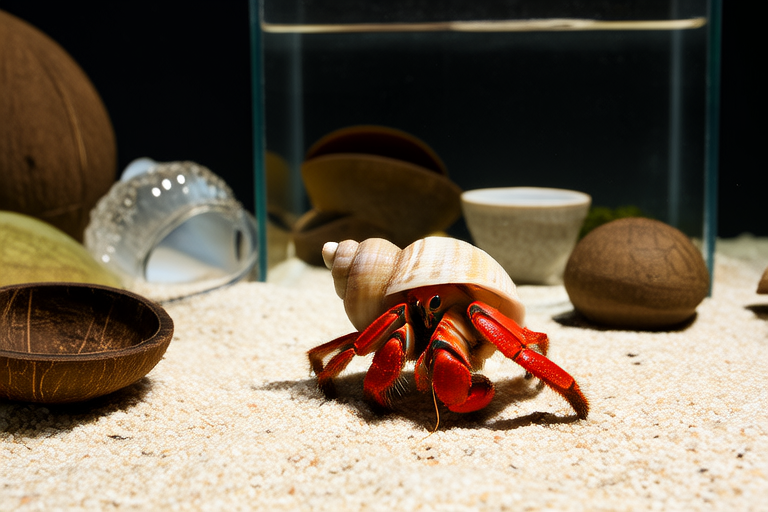Hermit Crab Care 101: Tips for New Pet Parents
Welcome to the wonderful world of hermit crabs! These fascinating creatures are becoming increasingly popular as pets due to their unique personalities and relatively low maintenance needs. However, providing proper care for hermit crabs requires understanding their specific needs and creating a suitable environment. This guide will walk you through the essentials of hermit crab care, from setting up the perfect habitat to maintaining their health and happiness.
Habitat Setup
The first step in hermit crab care is creating a comfortable home for your new pets. Hermit crabs thrive in environments that mimic their natural habitats. Start by selecting a spacious tank with a minimum capacity of 10 gallons per crab. The more space, the better, especially if you plan to keep multiple crabs together. A larger tank ensures adequate ventilation and allows your crabs to explore and interact without feeling cramped.
Proper ventilation is crucial for hermit crabs, so make sure the tank has a secure lid with plenty of air holes. You can also add a small fan to ensure continuous airflow. Additionally, include several hiding spots, such as coconut huts or cork bark, to provide your crabs with places to retreat when they feel stressed or need privacy.
Appropriate Substrate
Selecting the right substrate is vital for hermit crabs’ well-being. Opt for a mixture of calcium-rich sand and coconut fiber, which mimics the beaches where hermit crabs naturally live. Avoid using play sand or any substrate containing silica, as it can cause respiratory issues and other health problems. Ensure the substrate is at least two to three inches deep, allowing your crabs ample room to burrow and create tunnels.
Regularly check the substrate for cleanliness and replace it every few months to prevent bacterial growth and maintain hygiene. This will also help in keeping your crabs healthy and happy.
Temperature and Humidity Requirements
Hermit crabs require a warm and humid environment to thrive. Maintain a temperature range of 75 to 85 degrees Fahrenheit (24 to 29 degrees Celsius) within the tank. Use a reliable thermometer to monitor the temperature and adjust it using under-tank heaters if necessary. Be cautious not to exceed the upper limit, as excessive heat can be harmful to your crabs.
Maintaining proper humidity levels is equally important. Hermit crabs need a relative humidity of 70 to 80%. To achieve this, consider using a hygrometer to measure humidity and place a water dish filled with dechlorinated water inside the tank. Mist the tank daily to increase humidity, ensuring the substrate remains moist but not soggy. Soggy substrate can lead to fungal growth and respiratory issues.
Diet and Feeding Habits
Hermit crabs are omnivores and enjoy a varied diet. Offer them a mix of commercial hermit crab food, fresh fruits, vegetables, and occasional protein sources like boiled eggs or shrimp. It’s essential to provide a balanced diet to meet all nutritional requirements. Avoid feeding them processed foods, sugary treats, or anything containing pesticides or artificial additives.
Place food in shallow dishes within the tank and clean the dishes regularly to prevent mold growth. Rotate the types of food offered to encourage a diverse diet and avoid picky eating habits. Hermit crabs often eat at night, so you might notice more activity around mealtime during darker hours.
Handling Techniques
While hermit crabs are generally docile, handling them requires gentle care. Always support their shell with one hand while gently holding their body with the other. Avoid lifting them by their legs or antennae, as this can cause injury. Wash your hands before and after handling to prevent the transfer of oils or chemicals that may harm your crabs.
Resist the temptation to handle your hermit crabs too frequently. They are social creatures but still need time to acclimate to their environment and rest. Over-handling can stress them out and lead to health issues.
Common Health Issues
Despite being hardy pets, hermit crabs can face certain health issues if not cared for properly. One common problem is molting, a natural process where crabs shed their exoskeleton to grow. During this time, they become more vulnerable and may appear lethargic or hide for extended periods. Provide a separate molting box with a high-humidity environment to ensure a safe molt.
Another issue to watch for is shell rot, a condition where bacteria or fungi infect the shell, causing discoloration or foul odors. Regularly inspect the shells and change them if necessary. Additionally, monitor for signs of respiratory issues, such as labored breathing or mucus discharge, which may indicate poor environmental conditions.
Spotting Signs of Distress or Illness
Early detection of potential health problems is key to ensuring your hermit crabs stay healthy. Look out for signs of distress, such as decreased activity, loss of appetite, or changes in behavior. If you notice any of these symptoms, review their living conditions and adjust accordingly. Consult a veterinarian specializing in exotic pets for further guidance if needed.
Enrichment Activities
To keep your hermit crabs mentally stimulated and physically active, provide enrichment activities within their habitat. Introduce climbing structures like driftwood or rock formations to encourage exploration. Hide treats or food in different areas of the tank to promote foraging behavior. Rotate toys and decorations periodically to prevent boredom and stimulate curiosity.
Maintaining a Healthy Environment
A clean and well-maintained environment is essential for hermit crabs’ health and longevity. Regularly clean the tank, replacing substrate and cleaning water dishes as needed. Monitor temperature and humidity levels daily and make adjustments as required. Encourage a regular routine for feeding, misting, and tank maintenance to establish a stable and predictable environment for your crabs.
By following these guidelines and paying close attention to your hermit crabs’ needs, you’ll be able to provide them with a happy and healthy life. Remember, each crab is unique, so take the time to observe and understand their individual preferences. With proper care and attention, you and your hermit crabs can enjoy many years of companionship and adventure together.
